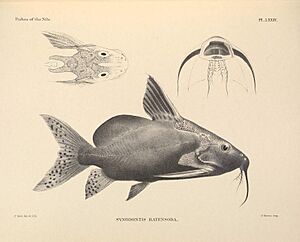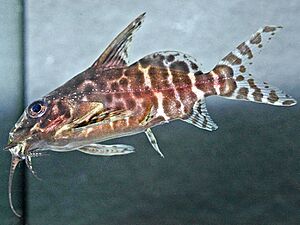Upside-down catfish facts for kids
Quick facts for kids Upside-down catfish |
|
|---|---|
 |
|
| Conservation status | |
| Scientific classification | |
| Synonyms | |
|
Synodontes ruppelli Swainson, 1838 |
The Synodontis batensoda, often called the upside-down catfish, is a unique fish from the family of mochokid catfish. It's famous for its habit of swimming upside down! You might also hear it called a "squeaker" or "giant upside-down catfish." This interesting fish lives in many rivers and waters across Africa, from Senegal in the west all the way to Ethiopia in the east. It was first described by a scientist named Eduard Rüppell in 1832.
Contents
Where Do Upside-Down Catfish Live?
This fish used to live in northern Africa, even in places like Cairo during floods. Sadly, it is no longer found there. Today, you can find the upside-down catfish in parts of the White Nile, Blue Nile, and Baro Rivers in northeast Africa. It also lives in the Chad, Niger, Senegal, and Gambia river systems in western Africa.
These catfish prefer slow-moving waters and marshy areas next to large rivers. The water in their natural homes is usually warm, between 23 to 27 degrees Celsius (73 to 81 degrees Fahrenheit).
What Do Upside-Down Catfish Look Like?
The upside-down catfish is usually silver-green to blue-grey. It has black whiskers, called barbels, and a blackish underside. This black belly is actually how it got its scientific name, batensoda, which means "black belly" in Arabic! Sometimes, these fish can also be reddish-brown.
Young upside-down catfish have large dark spots on their sides with lighter patches in between. They have many gill rakers, which are like filters in their gills, helping them breathe. They also have a short, deep body and large eyes.
Special Features of the Upside-Down Catfish
One of the most interesting things about this fish is that it almost always swims upside down! This helps it find food on the water's surface. It has a comb of small spines near its gill cover, called the operculum. Its tail fin is forked, with each part ending in a point.
These fish can grow quite large, up to 50 centimeters (about 20 inches) long. They can also weigh up to 1.5 kilograms (about 3.3 pounds).
What Do Upside-Down Catfish Eat?
The upside-down catfish is an omnivore, which means it eats both plants and animals. Its diet includes tiny living things called plankton, green algae, and detritus (dead bits of plants and animals). They also enjoy eating insects that land on the water's surface, chironomid larvae (which are a type of insect larva), small creatures that live on the riverbed like benthic crustaceans, and molluscs (like snails).
Life Cycle and Safety
Upside-down catfish are oviparous, meaning they lay eggs. They are also known to be venomous. This means they can deliver a mild sting if handled, which is a way they protect themselves. It's always best to observe fish in their natural habitat or in aquariums without touching them.
Upside-Down Catfish as Pets
In the world of aquariums, the upside-down catfish is known as a peaceful and tough fish. It gets along well with even small fish. However, it might be bothered by other, more aggressive types of Synodontis catfish.



